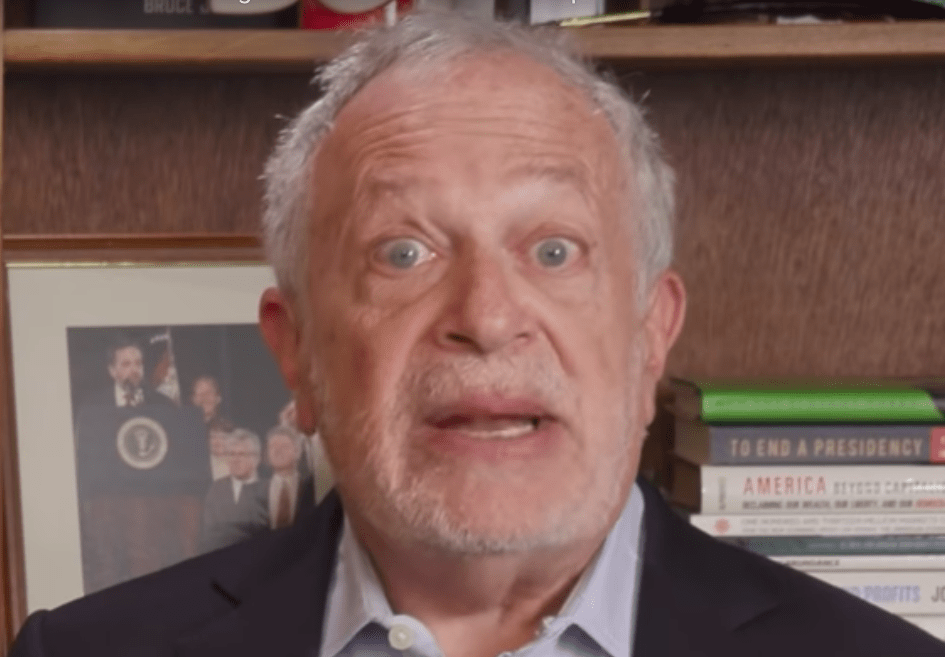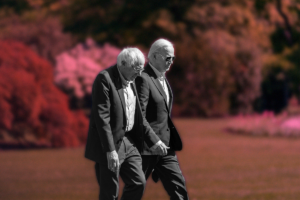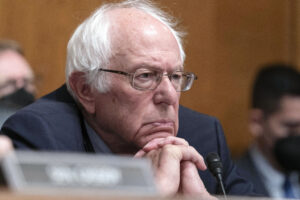Robert Reich: Bernie Sanders Is Not George McGovern
Democrats convinced that the Vermont senator would lose to Donald Trump vastly underestimate the risk of nominating a so-called moderate. Former Secretary of Labor Robert Reich. (YouTube screenshot)
Former Secretary of Labor Robert Reich. (YouTube screenshot)
The day after Bernie Sanders’s big win in Nevada, Joe Lockhart, Bill Clinton’s former press secretary, expressed the fear gripping the Democratic establishment: “I don’t believe the country is prepared to support a Democratic socialist, and I agree with the theory that Sanders would lose in a matchup against Trump.”
Lockart, like the rest of the Democratic establishment, is viewing American politics through obsolete lenses of left versus right, with Bernie on the extreme left and Trump on the far right. “Moderates” like Bloomberg and Buttigieg supposedly occupy the center, appealing to a broader swath of the electorate.
This may have been the correct frame for politics decades ago when America still had a growing middle class, but it’s obsolete today. As wealth and power have moved to the top and the middle class has shrunk, more Americans feel politically dis-empowered and economically insecure. Today’s main divide isn’t right versus left. It’s establishment versus anti-establishment.
Some background. In the fall of 2015 I visited Michigan, Wisconsin, Ohio, Pennsylvania, Kentucky, Missouri, and North Carolina, researching the changing nature of work. I spoke with many of the same people I had met twenty years before when I was secretary of labor, as well as some of their grown children. I asked them about their jobs and their views about the economy. I was most interested in their sense of the system as a whole and how they were faring in it.
What I heard surprised me. Twenty years before, most said they’d been working hard and were frustrated they weren’t doing better. Now they were angry – at their employers, the government, and Wall Street; angry that they hadn’t been able to save for their retirement, and that their children weren’t doing any better than they did. Several had lost jobs, savings, or homes in the Great Recession. By the time I spoke with them, most were employed but the jobs paid no more than they had two decades before.
I heard the term “rigged system” so often I began asking people what they meant by it. They spoke about the bailout of Wall Street, political payoffs, insider deals, CEO pay, and “crony capitalism.” These came from self-identified Republicans, Democrats, and Independents; white, black, and Latino; union households and non-union. Their only common characteristic was they were middle class and below.
With the 2016 primaries looming, I asked which candidates they found most attractive. At the time, party leaders favored Hillary Clinton or Jeb Bush. But the people I spoke with repeatedly mentioned Bernie Sanders and Donald Trump. They said Sanders or Trump would “shake things up,” “make the system work again,” “stop the corruption,” or “end the rigging.”
In the following year, Sanders – a 74-year-old Jew from Vermont who described himself as a democratic socialist and wasn’t even a Democrat until the 2016 presidential primary – came within a whisker of beating Hillary Clinton in the Iowa caucus, routed her in the New Hampshire primary, garnered over 47 percent of the caucus-goers in Nevada, and ended up with 46 percent of the pledged delegates from Democratic primaries and caucuses.
Trump, a 69-year-old ego-maniacal billionaire reality TV star who had never held elective office or had anything to do with the Republican Party, and lied compulsively about almost everything – won the Republican primaries and then went on to beat Clinton, one of the most experienced and well-connected politicians in modern America (granted, he didn’t win the popular vote, and had some help from the Kremlin).
Something very big happened, and it wasn’t because of Sanders’s magnetism or Trump’s likeability. It was a rebellion against the establishment. Clinton and Bush had all the advantages –funders, political advisors, name recognition – but neither could credibly convince voters they weren’t part of the system.
A direct line connected four decades of stagnant wages, the financial crisis of 2008, the bailout of Wall Street, the rise of the Tea Party and the “Occupy” movement, and the emergence of Sanders and Trump in 2016. The people I spoke with no longer felt they had a fair chance to make it. National polls told much the same story. According to the Pew Research Center, the percentage of Americans who felt most people could get ahead through hard work dropped by 13 points between 2000 and 2015. In 2006, 59 percent of Americans thought government corruption was widespread; by 2013, 79 percent did.
Trump galvanized millions of blue-collar voters living in places that never recovered from the tidal wave of factory closings. He promised to bring back jobs, revive manufacturing, and get tough on trade and immigration. “We can’t continue to allow China to rape our country, and that’s what they’re doing,” he roared. “In five, ten years from now, you’re going to have a workers’ party. A party of people that haven’t had a real wage increase in eighteen years, that are angry.” He blasted politicians and financiers who had betrayed Americans by “taking away from the people their means of making a living and supporting their families.”
Trump’s pose as an anti-establishment populist was one of the biggest cons in American political history. Since elected he’s given the denizens of C-suites and the Street everything they’ve wanted and hasn’t markedly improved the lives of his working-class supporters, even if his politically-incorrect, damn-the-torpedo’s politics continues to make them feel as if he’s taking on the system.
The frustrations today are larger than they were four years ago. Even though corporate profits and executive pay have soared, the typical worker’s pay has barely risen, jobs are less secure, and health care less affordable.
The best way for Democrats to defeat Trump’s fake anti-establishment populism is with the real thing, coupled with an agenda of systemic reform. This is what Bernie Sanders offers. For the same reason, he has the best chance of generating energy and enthusiasm to flip at least three senate seats to the Democratic Party (the minimum needed to recapture the Senate, using the vice president as tie-breaker).
He’ll need a coalition of young voters, people of color, and the working class. He seems on his way. So far in the primaries he leads among white voters, has a massive edge among Latinos, dominates with both women and men, and has done best among both college and non-college graduates. And he’s narrowing Biden’s edge with older voters and African Americans. [Add line about South Carolina from today’s primary.]
The “socialism” moniker doesn’t seem to have bruised him, although it hasn’t been tested outside a Democratic primary or caucus. Perhaps voters won’t care, just as they many don’t care about Trump’s chronic lies.
Worries about a McGovern-like blowout in 2020 appear far-fetched. In 1972 the American middle class was expanding, not contracting. Besides, every national and swing state poll now shows Sanders tied with or beating Trump. A Quinnipiac Poll last week shows Sanders beating Trump in Michigan and Pennsylvania. A CBS News/YouGov poll has Sanders beating Trump nationally. A Texas Lyceum poll has Sanders doing better against Trump in Texas than any Democrat, losing by just three points.
Instead of the Democratic establishment worrying that Sanders is unelectable, maybe it should worry that a so-called “moderate” Democrat might be nominated instead.
Independent journalism is under threat and overshadowed by heavily funded mainstream media.
You can help level the playing field. Become a member.
Your tax-deductible contribution keeps us digging beneath the headlines to give you thought-provoking, investigative reporting and analysis that unearths what's really happening- without compromise.
Give today to support our courageous, independent journalists.








You need to be a supporter to comment.
There are currently no responses to this article.
Be the first to respond.